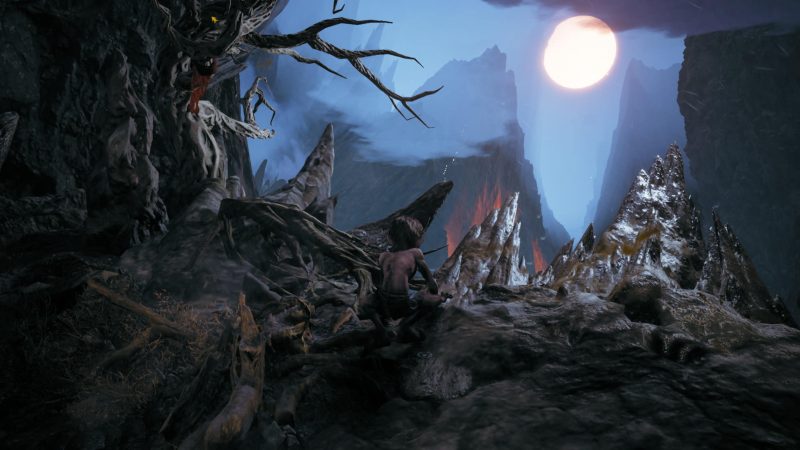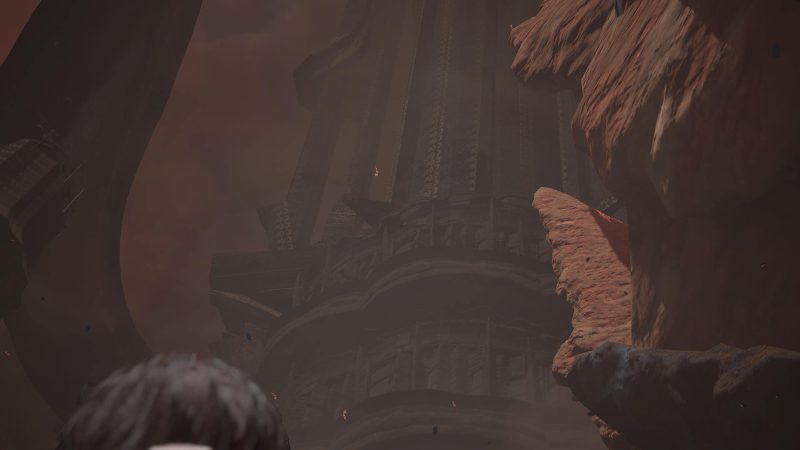The Lord of The Rings: Gollum Review (PS5) – Now that the day one patch released for The Lord of The Rings: Gollum, I was finally able to finish the game.
While I still had one random game crash post patch, nothing on the technical end of things kept me from finishing.
Regardless, the interesting story choices and world building can’t even come close to carrying the day, even for many fans of the books.
The Lord Of The Rings: Gollum Review (PS5) – A Little Less Shadows Of Mordor And A Lot More PS2 Fellowship Of The Ring
The opening moments of LOTR: Gollum see Gandalf interviewing Gollum about what the fallen Hobbit divulged to Sauron about the One Ring. Control then shifts to Gollum right around the time the slavers of Mordor imprison him.
Much of the time you spend in the game revolves around Gollum executing the demands of his captors as well as weaseling out a means of escaping. The most interesting mechanic in the game comes when making decisions.
Instead of simply choosing between options, you need to convince Gollum’s opposing personality of the choice you make.
In one instance, if you want to save a potential ally, you choose Smeagol’s option. You then have five chances to convince Gollum’s persona why that option benefits them the most.
The results come from a series of five points, and each point has three options. The outcomes of the three choices are not completely transparent, but they generally hint which side they support.
Unfortunately, while these events do create short-term differences in the story, they don’t affect the entire experience or add consequence to what you work through.
Ultimately, it serves as a fun addition, but it comes across more as a fixture to the game rather than a foundation of it.
Creative World Building
As mentioned at the beginning, much of the game sees you directing Gollum between random tasks from your captors or plotting your means of escape. The world design is captivating, considering there’s a mix of Elvish architecture with the sharp, unrefined metals of Sauron’s army.
Barad’ur looks great, quite Tolkien-esque, and vividly shows the love and care the team put into this game’s visuals.
With that in mind, a vast majority of the game is spent underground, muting a great deal of the overall color palette. Despite thoughtful design, the imagery loses a lot of luster just because of how many similar color tones the game uses.
There’s justification behind this, since after all this game takes place deep underground. It just doesn’t allow for much variation.
A creative choice Daedelic made is that Gollum does not have any sort of leveling or skill up mechanics. This choice proves effective in a game like this.
Considering that Gollum comes out the other side of these events with the same physical capabilities, giving him extra skills would feel more gimmicky than useful.
Instead, the dev team leaned into what made Gollum physically unique: he’s lanky, quick, quiet, and crafty.
This carries into his few gameplay mechanics as well. Gollum never takes an enemy head-on. Instead, he opts to either avoid, outsmart, or assassinate them (usually in that order).
Camera, the Boss Fight
In stealthy segments of the game, you move Gollum behind objects or keep to the shadows to avoid detection. The shadows play an especially significant role here, as Gollum blends into the shadow, making him invisible to enemies.
These sections of the game are essentially scripted, with a handful of them only challenging you with incredibly simplistic enemy patrol routes.
To make things easier, since the camera likes to get caught on environmental objects, Gollum has a special sense he can use to locate enemies around him. He can also use this to track scents, which also acts as a waypoint system.
One big portion of the gameplay loop in this game is platforming. This is where the game executes its greatest weaknesses. A good chunk of the time, platforming is a standard affair of jumping to nearby ledges, climbing walls, and navigating tunnels.
Nothing is inherently challenging here, in theory.
Platforming Mishaps
Where it starts to fall apart is how the game directs you to do these things. Like with myriad games before it, ledges you can grab have distinct colors, and walls you can climb have either streaks of white paint or lengths of threaded wood.
However, that’s not always the case. Sometimes, though, ledges lack any sort of clear definition or highlight.
Plenty of times, I had to just hope that I had a ledge to grab onto and went for it. In these situations, what I thought was the ledge ended up not being where Gollum automatically grabbed.
Getting to faraway ledges is a mixed experience as well. Someone, Gollum practically slides through the air to the ledge. Other times, you can run and jump and fall short of something closer than a ledge Gollum slides to.
Lots of cheap deaths occur from this game’s platforming, and that frustration keeps coming back.
Then there are times where you need to jump from one wall to another. Sometimes, Gollum says something to prompt you to jump.
Other times, the game gives you a prompt to press Square and jump backwards. Other times, however, nothing appears and Gollum says nothing.
Either Humdrum or Cumbersome
These usually happen in tight spaces, both vertical and horizontal, where the camera proves the most difficult to control. By the time you figure it out, you’re already frustrated because the effort wasn’t worth the result.
Even without that issue, the platforming in this game proves humdrum at best and cumbersome at worst. When climbing walls, Gollum gets stuck on random things out of nowhere, and getting up from ledges often takes several attempts at the joystick input.
One particular sequence sees you riding a cart and avoiding obstacles by hanging off the side of the cart or jumping.
These obstacles aren’t terribly close together, so it’s not a choreographed affair, but the issues mentioned above makes this part much harder than it should be.
Ultimately, if the platforming portions of the game had been much simpler, then the game could have been much easier to swallow, even for non-fans.
There’s a lot of ambition put into this project but the final product indicates that the necessary resources and expertise weren’t there to make it engaging.
Tolkien Fan Response
I was regularly reminded of that PS2 game of Lord of The Rings: The Fellowship of The Ring. Much like this game, that game was truly only for hardcore fans hungry for something in Middle-Earth.
The big difference between these two games, though, is that Fellowship of The Ring is just dull – where Gollum is frustrating, and dull.
Apart from finishing this review, the only other reason I constantly pushed through gameplay was to see the cutscenes. Daedalic made some interesting choices in who Gollum encounters and what he ends up doing within the overall Lord of The Ring mythos.
The team didn’t take many risks at all, especially with having both good and bad endings.
At the same time, whether this game is recognized as canon or not, there’s an interesting bit in the good ending that shows how the Elves of Mirkwood may have first learned about the growing threat of Mordor. Either way, this is a one off line in the game that only fans will care about.
Finally, there are puzzles in this game. In the beginning portions of the game, everything is humdrum, even the puzzles. This bland formula turns your brain off for when the puzzles become decent.
On their own, the puzzles and their solutions are confined to small spaces, which works in their favor.
Ultimately, the puzzles work rather well in how the game lays them out. Still, after a stretch of your brain being off, being forced to think so hard feels more demanding than intriguing.
Only For The Die-Hards of the Die-Hard Fans
The Lord of The Rings: Gollum shows its hand from the start – cumbersome gameplay that encompasses a narrative built by loving Tolkien fans.
There’s something here, lurking in the dark, for only the most dedicated fans. Other than that, this game needed much more than the year delay it took.
The Lord Of The Rings: Gollum is now available on PS5 and PS4.
Review code kindly provided by the publisher.








